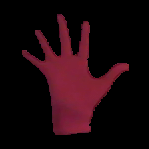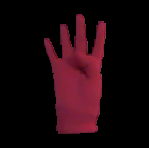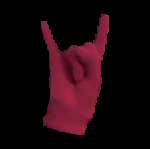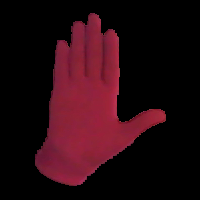LSA16: A Handshape Dataset for the Argentinian Sign Language
This database contains images of 16 handshapes of the Argentinian Sign Language (LSA), each performed 5 times by 10 different subjects, for a total of 800 images. The subjects wore color hand gloves and dark clothes.
Handshapes
The following table lists the id and name of each handshape, along with a sample.
| ID | Name | Sample | ID | Name | Sample | ID | Name | Sample | ID | Name | Sample |
|---|---|---|---|---|---|---|---|---|---|---|---|
| 01 | Five |  |
02 | Four |  |
03 | Horns |  |
04 | Curve |  |
| 05 | Fingers together |  |
06 | Double |  |
07 | Hook |  |
08 | Index |  |
| 09 | L |  |
10 | Flat Hand |  |
11 | Mitten |  |
12 | Beak |  |
| 13 | Thumb |  |
14 | Fist |  |
15 | Telephone |  |
16 | V |  |
Recording
The dataset was recorded in an indoors environment, with artificial lightning.
Subjects wore dark clothes and performed the handshapes standing, with a white wall as a background. To simplify the problem of hand segmentation, subjects wore fluorescent-colored gloves. These substantially simplify the problem of recognizing the position of the hand and performing its segmentation, and remove all issues associated to skin color variations, while fully retaining the difficulty of recognizing the handshape. The subjects performed the same handshape with both hands.
Each handshape was executed imposing few constraints on the subjects to increase diversity and realism in the database. All subjects were non-signers and right-handed, were taught how to perform the handshape during the shooting session by showing them an image of the handshape as performed by one of the authors, and practiced each handshape a few times before recording.
We employed a generic webcam for the recording, with a resolution of 640 by 480.
License 
This work is licensed under a Creative Commons Attribution-NonCommercial-ShareAlike 4.0 International License.
This basically means that:
- Academic, educational or personal use is allowed without restrictions.
- You must share any derivative works under the same license (ie, preprocessed versions of the dataset, subsets, supersets using other datasets).
- You must mention this website or the article Handshape recognition for Argentinian Sign Language using ProbSom whenever you share or mention the dataset.
- Commercial uses of the dataset are not allowed.
Please contact the authors if you are unsure about what constitutes fair use under this license, or need to use the dataset under a different license.
Raw version
The raw version of the dataset contains one image for each handshape instance in the dataset. Each image weights 0.33mb on average.
The filename of each image specifies its class, subject, and repetition, in the format CLASS_SUBJECT_REPETITION.png. For example, the image 3_2_4.png corresponds to the 4th repetition of handshape 3 (Horns), as performed by subject 2.
Segmented version
We provide a segmented version of the dataset to reduce the overhead of performing experiments with the data. From each image we extracted the only the right hand and segmented it, replacing the background with black pixels. The filename format is the same as in the raw version. We provide only the segmented hand images. The details of how the images were segmented are described in Handshape recognition for Argentinian Sign Language using ProbSom, but we basically used a simple color thresholding + opening + biggest connected component detection pipeline.
Citing
If you use the dataset in your research, we kindly ask you to cite the article Handshape recognition for Argentinian Sign Language using ProbSom:
@Article{Ronchetti2016,
author="Ronchetti, Franco and Quiroga, Facundo and Lanzarini, Laura and Estrebou, Cesar",
title="Handshape Recognition for Argentinian Sign Language using ProbSom",
journal=" Journal of Computer Science and Technology ",
year="2016",
volume="16",
number="1",
pages="1--5",
issn="1666-6038"
}
Articles and projects using LSA16
- Handshape Recognition using PrincipalComponent Analysis and ConvolutionalNeural Networks applied to Sign Language (PhD thesis)
- A Study of Convolutional Architectures for Handshape Recognition applied to Sign Language
- Reconocimiento de gestos dinámicosy su aplicación al lenguaje de señas (PhD thesis, spanish)
- A Study of Convolutional Architectures for Handshape Recognition applied to Sign Language
- Handshape dataset loading library (python, github)
Samples
Sample images of the dataset.










Contact
Facundo Manuel Quiroga {fquiroga}-at-lidi.info.unlp.edu.ar
III-LIDI Informatics Institute Informatics Faculty UNLP
